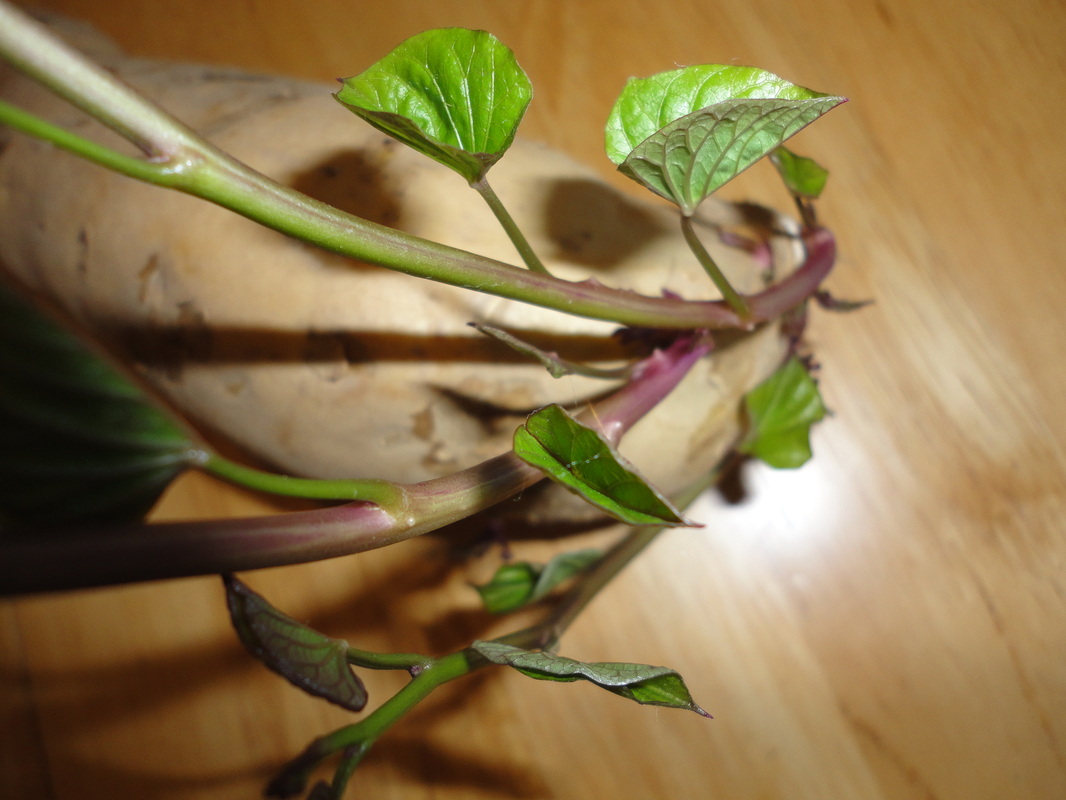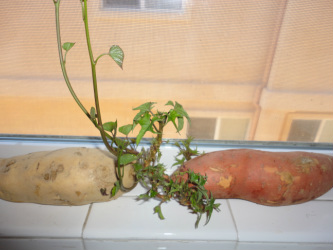Is it a sweet potato or a yam?
The colors are different. The leaves are different. They even taste different! I've been told by many people over the years that they are one and the same. I NEVER believed they were the same potato. Sooooooooooooooooooooooo . . . , of course I Googled it and found that I was right. I love being right! (Doing the "I was right" happy dance! dum de dum de dum)
A sweet potato is just that, a potato that tastes a little sweeter than a normal potato, plain and simple. A yam is that ever loving yummy goodness dark orange potato that lands on your table at Thanksgiving (in chunks or mashed) drowning in butter and smothered in brown sugar and baby marshmallows. Being Vegan and more a Raw Foodist, I think is unnecessary to put anything on them because it tastes fabulous all on it's little own. Bake, cool, peel and eat! Drool!
No one will give a rat's behind that there is a difference and that everything is misnamed. I don't either. You can still call it what you want - Sweet Potato Pie, Sweet Potato Fries, Sweet Potato Casserole, etc. but just know - it's really yams!
Either way, they look cool growing in my kitchen windowsill. I bought some of both, placed the bag of onions on them "just for a minute," forgot about them, and they proceeded to take matters into their own hands. Surprise!
A sweet potato is just that, a potato that tastes a little sweeter than a normal potato, plain and simple. A yam is that ever loving yummy goodness dark orange potato that lands on your table at Thanksgiving (in chunks or mashed) drowning in butter and smothered in brown sugar and baby marshmallows. Being Vegan and more a Raw Foodist, I think is unnecessary to put anything on them because it tastes fabulous all on it's little own. Bake, cool, peel and eat! Drool!
No one will give a rat's behind that there is a difference and that everything is misnamed. I don't either. You can still call it what you want - Sweet Potato Pie, Sweet Potato Fries, Sweet Potato Casserole, etc. but just know - it's really yams!
Either way, they look cool growing in my kitchen windowsill. I bought some of both, placed the bag of onions on them "just for a minute," forgot about them, and they proceeded to take matters into their own hands. Surprise!
The Sweet Potato Vs. The Yam
I borrowed the verbiage below from http://web.med.harvard.edu
Despite their similar appearance, these tuber vegetables are unrelated. The sweet potato is the root of a member of the morning glory family. It is native to Central America and is now cultivated in most sub-tropical areas of the world. There are many varieties that differ in size, shape, and color. The two main categories are ‘soft’ and ‘firm,’ referring to their consistency when cooked. The soft ones often have orange flesh and are often incorrectly called yams. The firm varieties have white or yellow flesh. Sweet potatoes have a 3-6% sugar content, which is increased by storage at warm temperatures and during the early stages of the cooking process when enzymes break down the starch into glucose. The sweet potato provides more calories, minerals, and vitamin A (indicated by the orange color), but less protein, than the regular old white potato.
Yams are the root of a plant that is related to the grasses and lilies. It is thought to have originated in Asia, but similar to the sweet potato, is now grown on most of the continents. The origin of the word yam is interesting. Portuguese slave traders watched Africans digging up the roots and asked what they there were. The Africans replied with nyami, meaning ‘something to eat.’ This became inhame in Portuguese, then igname in French and yam in English. Yams have a bitter taste when raw and must be cooked to be edible. Similar to the sweet potato, there are many different varieties. However, we tend to see the same variety of sweet potato and yam in our grocery stores. Yams have a high starch content and tends to be less sweet than the sweet potato.
Here'es the link ~ http://web.med.harvard.edu/sites/murmur/html/articles/032204/032204_mperencevich.asp
I borrowed the verbiage below from http://web.med.harvard.edu
Despite their similar appearance, these tuber vegetables are unrelated. The sweet potato is the root of a member of the morning glory family. It is native to Central America and is now cultivated in most sub-tropical areas of the world. There are many varieties that differ in size, shape, and color. The two main categories are ‘soft’ and ‘firm,’ referring to their consistency when cooked. The soft ones often have orange flesh and are often incorrectly called yams. The firm varieties have white or yellow flesh. Sweet potatoes have a 3-6% sugar content, which is increased by storage at warm temperatures and during the early stages of the cooking process when enzymes break down the starch into glucose. The sweet potato provides more calories, minerals, and vitamin A (indicated by the orange color), but less protein, than the regular old white potato.
Yams are the root of a plant that is related to the grasses and lilies. It is thought to have originated in Asia, but similar to the sweet potato, is now grown on most of the continents. The origin of the word yam is interesting. Portuguese slave traders watched Africans digging up the roots and asked what they there were. The Africans replied with nyami, meaning ‘something to eat.’ This became inhame in Portuguese, then igname in French and yam in English. Yams have a bitter taste when raw and must be cooked to be edible. Similar to the sweet potato, there are many different varieties. However, we tend to see the same variety of sweet potato and yam in our grocery stores. Yams have a high starch content and tends to be less sweet than the sweet potato.
Here'es the link ~ http://web.med.harvard.edu/sites/murmur/html/articles/032204/032204_mperencevich.asp





 RSS Feed
RSS Feed


